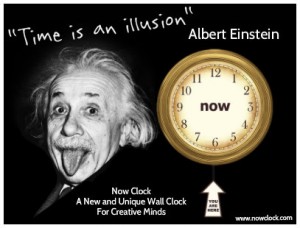Science Seen Physicist and Time One author Colin Gillespie helps you understand your world.
Saving Time
 Last week’s post looked at how physics turned its back on time. It had consequences. Today, leading physicists speak of time in despairing terms. Some propose to abandon it. Though buried deep in science journals, this situation eats at the roots of our economy. Is time lost beyond recall?
Last week’s post looked at how physics turned its back on time. It had consequences. Today, leading physicists speak of time in despairing terms. Some propose to abandon it. Though buried deep in science journals, this situation eats at the roots of our economy. Is time lost beyond recall?
Let’s recap: In 1905 Albert Einstein invents special relativity (SR). Its math describes what one sees when watching moving meter sticks and clocks. It speaks of local 3-D space and 1-D time. Its messages are: No absolute time; no absolute unmoving space (sometimes called no absolute frame).
In 1907 German mathematician Hermann Minkowski grabs SR and turns it into 4-D spacetime. Its symmetric math seems to speak of the whole universe. With it he adds new messages: Space and time are basically the same; time does not pass; there is no now. Craig Callender says:
The equations of physics do not tell us which events are occurring right now—they are like a map without the “you are here” symbol. The present moment does not exist in them, and therefore neither does the flow of time.
 These messages, both Einstein’s and Minkowski’s, are true of spacetime and its math. They are not true of our universe. In the years after Minkowski dies, many relativists—those concerned with local physics—embrace his spacetime as if its messages are reality. Their time takes a wrong turn.
These messages, both Einstein’s and Minkowski’s, are true of spacetime and its math. They are not true of our universe. In the years after Minkowski dies, many relativists—those concerned with local physics—embrace his spacetime as if its messages are reality. Their time takes a wrong turn.
The good news is: At the same time, cosmologists—physicists concerned with the whole universe—save time! They don’t take that turn. They need an unmoving 3-D frame of reference and a time that’s absolute. On this foundation, they (Einstein among them!) build cosmology into a new branch of physics, making small mention of their inconsistency with spacetime. Canadian cosmologist Daryl Janzen says:
Einstein was the first to take the step, in relativistic cosmology, back towards the description of the universe as absolute three-dimensional space that exists (evolves, endures) in the course of absolute time.
At the time, this step back is an intuitive move, lacking evidence. Decades later, evidence is found. Physicists detect the Big Flash, light emitted by the infant universe (380,000 years—a mere moment in cosmological terms—after its beginning). This light, stretched to far infrared by the universe’s expansion, reaches us from all directions. By comparing colours from different directions, physicists define an absolute 3-D frame that has existed since the dawn of time, relative to which our Sun is now moving at 371 km/s (830,000 miles per hour).
The step back is now a central pillar of modern cosmology. It says a 3-D universe exists (a notion that is well known to philosophers). It rescues time. And it says 4-D spacetime is just a map, a way to describe events that happen in space.
This is good news for us too. It means that now—the present—is not only special compared to the past or future, as our senses say; the present is all that exists. It means too that time is not an illusion (as many physicists still believe it to be). Time as we perceive it, the continuation of existence, rests on the deepest level of reality.
Next: Einstein’s SR says simultaneity is relative. Does Einstein’s 3-D universe say simultaneity is absolute?
Sources:
Daryl Janzen (2014), “Einstein’s Cosmological Considerations”, arXiv.org, Ithaca: Cornell University Library, p.42, http://arxiv.org/pdf/1402.3212v1
Craig Callender (2010), “Is Time an Illusion?”, Scientific American, June, p. 58; http://www.scientificamerican.com/article/is-time-an-illusion/
Dale Fixsen et al. (1996), “The Cosmic Microwave Background Spectrum from the Full COBE/FIRAS Data Set”, The Astrophysical Journal, London: Institute of Physics, vol. 473, p. 586; arXiv.org, Ithaca: Cornell University Library, p. 26, http://arxiv.org/abs/astro-ph/9605054
Jean-Paul Sartre (1938), La Nausée, Paris: Éditions Gallimard; Robert Baldick (tr., 1965), Nausea, New York: Penguin Books, p. 124; http://www.amazon.ca/Modern-Classics-Nausea-Jean-Sartre/dp/014118549X
Image sources:
Nextide Academy, “Time is an illusion”, http://www.nextideacademy.org/time-is-an-illusion/
Wikimedia, http://upload.wikimedia.org/wikipedia/commons/1/1f/Minkowski_lightcone_lorentztransform_inertial.svg
Iz Quotes, http://izquotes.com/quote/264612

No comments yet.